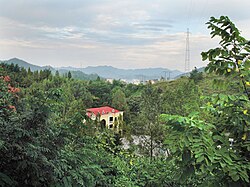Zhangwan
张湾区 | |
|---|---|
 Sports building of Dongfeng High School | |
| Coordinates (Zhangwan government): 32°39′07″N 110°46′08″E / 32.652°N 110.769°E | |
| Country | China |
| Province | Hubei |
| Prefecture-level city | Shiyan |
| District seat | Checheng Road Subdistrict |
| Area | |
| • Total | 657 km2 (254 sq mi) |
| Population (2020 census)[2] | |
| • Total | 431,859 |
| • Density | 660/km2 (1,700/sq mi) |
| Time zone | UTC+8 (China Standard) |
| Postal code | 442000 |
| Website | www |
Zhangwan District (simplified Chinese: 张湾区; traditional Chinese: 張灣區; pinyin: Zhāngwān Qū) is a district of the city of Shiyan, Hubei, China.[1][3]
History[edit]
Human activity in the area can be traced back to approximately 5000 BCE on the banks of the Du River.[1]
The area belonged to the Chu State during its existence.[1] The area later belonged to the Qin dynasty.[1]
The area was incorporated under the Jin dynasty as Weiyang County (微阳县).[1]
During the Sui dynasty and the early Tang dynasty, the area was incorporated as Duyang County (堵阳县).[1] In 627 CE, the county was dissolved and replaced by Yunxiang County (郧乡县).[1] Yunxiang County would itself be dissolved in 1277 under the Southern Song, and replaced by Yun County (郧县).[1] The area would remain as Yun County throughout subsequent dynasties, and through the rule of the Republic of China.[1]
In December 1947, Yun County was taken by Communist forces.[1] In subsequent years, the area would be re-organized multiple times.[1] The prefecture-level city of Shiyan was established in December 1969.[1]
Zhangwan was established as a county-level subdistrict (县级街道) in November, 1980.[1]
In May 1984, Zhangwan was re-organized as a district (区).[1]
On 13 June 2021, a gas explosion occurred in Zhangwan District.[4]
Geography[edit]
The district is located near the geographic center of Shiyan, bordering Maojian District to its southeast, and bordering Yunyang District elsewhere.[1]
Climate[edit]
Zhangwan District has a subtropical climate with four distinct seasons, long winters and summers, and short springs and autumns.[1] The average annual sunshine in the district is 1889.3 hours, the annual average temperature is 15.25 °C, and the annual average precipitation is 1000.8 millimetres.[1]
Administrative divisions[edit]
Zhangwan District administers 4 subdistricts, 2 towns, 2 townships, and 2 other township-level divisions.[3]
|
|
2 other township-level divisions are: Xicheng Development Zone (西城开发区) and Shiyan Industrial New Area (十堰工业新区).
Demographics[edit]
In the 2010 Chinese census, Zhangwan had a population of 368,471 people.[5] By 2015, the district's population rose to approximately 399,000 people.[6] By 2018, the district's population had risen further to approximately 415,000 people.[1]
Economy[edit]
As of 2018, Zhangwan District reported a GDP of 55.905 billion Yuan, of which, the primary sector contributed 0.288 billion Yuan, the secondary sector contributed 37.462 billion Yuan, and the tertiary sector contributed 18.155 billion Yuan.[1] In 2018, retail sales in the district totaled 15.3 billion Yuan, and government revenue totaled 1.09 billion Yuan.[1]
Agriculture, forestry, animal husbandry, and fishing contributed 489 million Yuan to the district's economy in 2018, the majority of which came from agriculture.[1] Major agricultural products in the district include wheat, corn, rice, and tea.[1]
Industry in the district is dominated by Dongfeng Motors, which operates a number of manufacturing plants in the district, producing commercial vehicles, off-road vehicles, and auto chassis.[1]
The district government is partaking in an ongoing poverty alleviation program, which it spent 390 million Yuan on in 2018, aiding 7,639 people.[1]
A number of natural sites in the district have been outfitted with tourism infrastructure, and there is significant tourism to Dongfeng's current and historic plants in the district.[1]
Transportation[edit]
Rail[edit]
The Xiangyang–Chongqing railway runs through the district.[1]
Road[edit]
National Highway 209, National Highway 316, and the Yinchuan-Wuhan section of the G70 Expressway all pass through the district.[1]
References[edit]
- ^ a b c d e f g h i j k l m n o p q r s t u v w x y z aa ab 张湾区情概况 [Zhangwan District Overview] (in Chinese). Zhangwan District People's Government. 2020-05-07. Archived from the original on 2020-07-09. Retrieved 2020-07-09.
- ^ "十堰市第七次全国人口普查公报(第一号)——地区人口情况" (in Chinese). Shiyan Municipal Bureau of Statistics. 2021-07-12.
- ^ a b 2022年统计用区划代码 (in Chinese). National Bureau of Statistics of the People's Republic of China.
- ^ "湖北十堰燃气爆炸事故现场附近居民:菜市场处于坍塌状态 附近小区暂停供应水、电、天然气_央广网". china.cnr.cn. Retrieved 2021-06-13.
- ^ 张湾区历史沿革 [Zhangwan District Historical Development] (in Chinese). XZQH.org. 22 July 2014. Retrieved 22 November 2018.
1996年,张湾区面积650平方千米,{...}2010年第六次人口普查,张湾区常住总人口368471人,其中:花果街道49027人,红卫街道85628人,车城路街道121907人,汉江路街道77559人,黄龙镇14291人,柏林镇8689人,方滩乡3442人,西沟乡3345人,西城开发区4090人,秦家坪林场229人,凤凰山茶场264人。
- ^ 张湾区情概况 [Zhangwan District Overview] (in Chinese). Zhangwan District People's Government. 12 July 2016. Archived from the original on 2018-08-14. Retrieved 22 November 2018.
面积657平方公里,2015年人口39.9万人。{...}2015年底,张湾区辖2乡2镇4个街道1个省管经济开发区(十堰市西城经济开发区),总人口39.9万人,{...}行政区{...}车城路街道{...}汉江路街道{...}红卫街道{...}花果街道{...}柏林镇{...}黄龙镇{...}西沟乡{...}方滩乡{...}西城经济开发区
